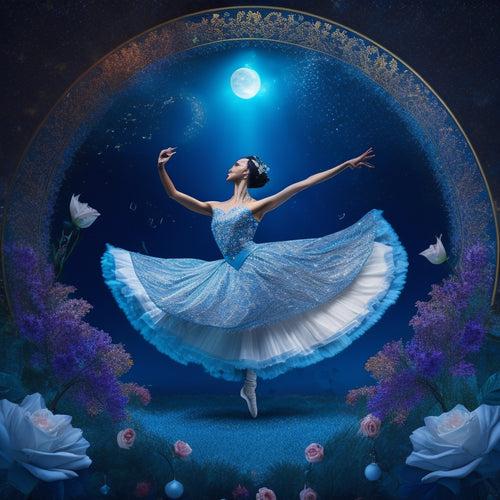
Rhythmic Revolution: The Tap Dance Legacy
Share
As I explore the rich cultural heritage of tap dance, I'm struck by the rhythmic fusion of African polyrhythms, Irish lilting rhythms, and English clog dancing that has evolved into a distinctive percussive art form. The evolution of tap technique is marked by innovations in materials and designs, from steel plates to custom-made taps, expanding tonal possibilities and footwork innovations. Legendary masters have pushed boundaries with iconic performances, characterized by precision, rhythmic mastery, and improvisation-driven innovations. As I continue to unravel the threads of this vibrant legacy, I'm excited to uncover more about the art form's transformative power.
Key Takeaways
• Tap dance's rhythmic expression is rooted in African, Irish, and English influences, fusing diverse cultural threads into a unique art form.
• The evolution of tap technique has been shaped by advancements in materials, from steel plates to ergonomic designs, expanding tonal possibilities and footwork innovations.
• Legendary tap dancers have elevated the art form through iconic performances, pushing boundaries with precision, rhythmic mastery, and improvisation-driven innovations.
• The use of polyrhythms and syncopation reflects African influences, while lilting rhythms and lively steps evoke Irish connections, showcasing cultural fusion.
• Modern tap dance has been revolutionized by masters who have experimented and innovated, leaving a lasting impact on the art form through their contributions.
Roots of Rhythmic Expression
As I explore the roots of rhythmic expression, it becomes clear that tap dancing's eclectic heritage is deeply rooted in the convergence of African tribal dances, Irish jigs, and English clog dancing, which ultimately gave birth to a unique American art form.
The African influences are undeniable, with polyrhythms and syncopation echoing through the ages.
The Irish connections are also palpable, as the lilting rhythms and lively steps of the jig found their way into the early tap repertoire.
This cultural fusion created a distinctive sound, a blend of earthy, percussive beats and lilting, airy melodies.
As I investigate further, I realize that tap dancing's rich tapestry is woven from these diverse threads, each strand contributing to the vibrant, kinetic art form we understand today.
Evolution of Tap Technique
Through the years, I've observed that the evolution of tap technique has been marked by a gradual refinement of metalwork, leading to more nuanced and expressive rhythmic capabilities. Modern influences have introduced new materials and designs, allowing for a wider range of tonal possibilities. This has enabled dancers to experiment with innovative footwork, pushing the boundaries of the art form.
| Technique Evolution | Key Developments |
|---|---|
| 1920s-40s | Introduction of steel plates, allowing for louder sounds |
| 1950s-60s | Experimentation with aluminum and other lightweight materials |
| 1970s-80s | Development of custom-made taps for individual dancers |
| 1990s-present | Use of advanced materials and ergonomic designs |
As a result, tap dance has become a more expressive and dynamic art form, with dancers able to convey complex emotions and tell stories through their feet.
Masters of the Craft
I've had the privilege of exploring numerous tap dance legends, each leaving an indelible mark on the art form, and I'd like to investigate the remarkable careers of a few masters who've elevated tap dancing to unprecedented heights.
These masters have consistently pushed the boundaries of the craft, delivering iconic performances that redefine the possibilities of tap. Legendary footwork, precision, and rhythmic mastery are hallmarks of their work.
The influence of improvisation has allowed them to innovate and experiment, leading to artistic innovations that have transformed the genre. By examining the careers of these masters, I hope to uncover the secrets behind their enduring impact on tap dance.
Frequently Asked Questions
Can I Learn Tap Dancing at an Older Age?
"As a senior enthusiast, I'm thrilled to discover that age is just a number when it comes to tapping into my rhythm; with patience and practice, I can master ageless moves, proving that tap dancing is truly a lifelong passion."
Are Tap Shoes Only Worn for Performances?
As I lace up my trusty tap shoes, I wonder, are they only for performances? Nope, I wear them for everyday practice too, ensuring my Tap Shoe Maintenance is on point, and my Everyday Tap Style stays sharp.
Can I Create My Own Tap Dance Style?
Silky syncopation stirs within me as I ponder creating my own tap dance style, blending Tap Fusion with Rhythm Evolution, where every step becomes a symphony, and I'm the conductor, crafting a unique rhythm that resonates with my soul.
How Do I Choose the Right Tap Shoes for Beginners?
When choosing tap shoes as a beginner, I prioritize Sole Support for comfort and stability, and Heel Height to guarantee a secure fit, allowing me to focus on mastering my rhythm without distraction.
Are There Any Health Benefits to Tap Dancing Regularly?
As I lace up my taps, I'm thrilled to know that 30 minutes of tap dancing can burn up to 200 calories - that's a cardio blast! Regular tap dancing also sharpens my mental clarity, boosting focus and memory.
Related Posts
-

Learn Dance Makeup Artistry Online: A Step-by-Step Guide
You're about to begin an exciting journey to master the art of dance makeup online! First, you'll need to select the ...
-

Exclusive Crafting Files: Dance Mom Delight
Dance Mom Delight offers a wide collection of exclusive crafting files, providing users with a diverse range of digit...
-

Barbara Ana's Dancer: Enchanting Cross Stitch Pattern
Barbara Ana's Dancer is a captivating cross stitch pattern that captures the essence of festive stitching. This charm...


